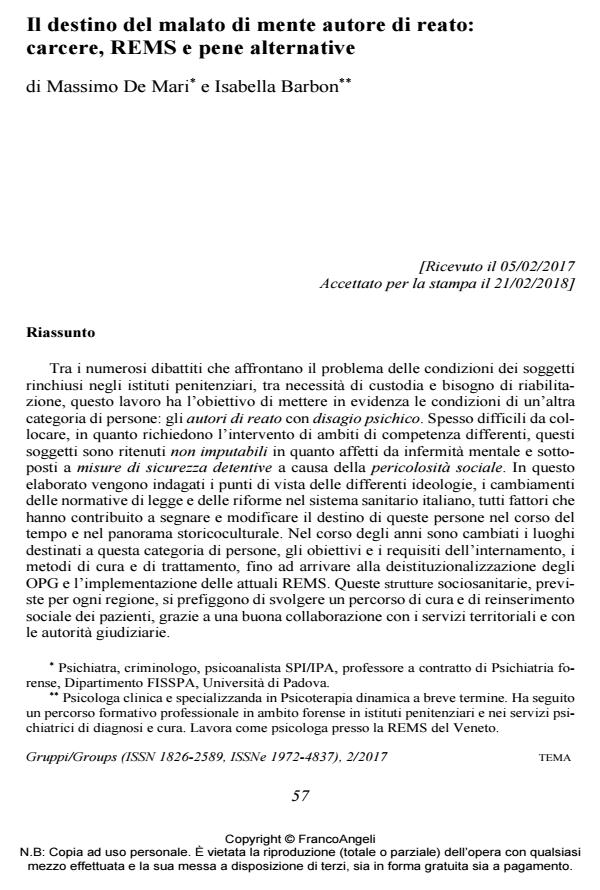The fate of the mentally ill criminal: prison, rehab institutions and alternatives to prison
Journal title GRUPPI
Author/s Massimo De Mari, Isabella Barbon
Publishing Year 2018 Issue 2017/2
Language Italian Pages 21 P. 57-77 File size 210 KB
DOI 10.3280/GRU2017-002006
DOI is like a bar code for intellectual property: to have more infomation
click here
Below, you can see the article first page
If you want to buy this article in PDF format, you can do it, following the instructions to buy download credits

FrancoAngeli is member of Publishers International Linking Association, Inc (PILA), a not-for-profit association which run the CrossRef service enabling links to and from online scholarly content.
Among the many debates on the issue of how incarcerated individuals are dealt with inside penitentiary institutions, between need for custody and need of rehabilitation, this article highlights the state of the art of a specific category of people: offenders with psychic distress. Often difficult to place, as they require intervention within different areas of expertise, these individuals are deemed not to be imputable because they suffer from mental illness. They are therefore subjected to detention security measures because of social danger. This paper elaborates on the standpoints of all different ideologies, on the changes in legislation and on the recent reforms in the Italian health-care system; all these factors, over time, have marked and changed the fate of these people on a historical and cultural level. Over the years there have been changes in the places destined to this category of people, in the objectives and the requirements of confinement, in the methods of treatment, which led to the deinstitutionalization of OPG structures and the implementation of the current REMS structures. These health-care structures, one for each Italian region, aim at conducting a treatment and social reintegration program for all patients, thanks to an efficient collaboration with other health-care services of the area and with the judicial authorities.
Keywords: Prison, Rehab institution, Psychiatric expertise, Crime, Forensic psychotherapy, Mentally ill criminal.
- Alibrandi L. e Corso P., a cura di (2016). Codice penale e di procedura penale e leggi complementari. Piacenza: La Tribuna.
- Antolisei F. (2008). Manuale di diritto penale. Parte Generale. Milano: Giuffrè.
- Balier C. (1988). Psychanalyse des comportements violents. Paris: PUF.
- Basaglia F. (1968). L’istituzione negata. Torino: Einaudi.
- Benigni B. (2008). Sani dentro: cronistoria di una riforma. Verona: Noema.
- Bertolino M. (1990). L’imputabilità e il vizio di mente nel sistema penale italiano. Milano: Giuffrè.
- Borzacchiello A. (2007). I luoghi della follia. L’invenzione del manicomio crimi-nale. -- Testo disponibile al sito: http://www.museocriminologico.it/documenti/carcere/manicomio_criminale.pdf
- Canestrari S., Cornacchia S. e De Simone G. (2007). Manuale di diritto penale. Parte generale. Bologna: Il Mulino.
- Canestrari S., Cornacchia L., Gamberini A., Insolera G., Manes V., Mantovani M., Mazzacuva N., Sgubbi F., Storini L. e Tagliarini F. (2009). Diritto penale. Li-neamenti di parte speciale. V ed., Bologna: Monduzzi.
- Canosa R. (1979). Storia del manicomio in Italia dall’Unità ad oggi, Milano: Fel-trinelli.
- De Ferrari F. e Romano C.A. (2003). Sistema penale e tutela della salute. Milano: Giuffrè.
- Douglas K.S., Hart S.D., Webster C.D. & Belfrage H. (2013). The Historical Clinical Risk Management-20, Version 3 (HCR-20V3): Development and Overview. International Journal of Forensic Mental Hearlth, 13: 93-108.
- Fornari U. (2004). Trattato di psichiatria forense. Torino: UTET.
- Goffman E. (2003). Asylums. Le istituzioni totali: i meccanismi dell’esclusione e della violenza. Torino: Einaudi.
- Hare R.D. (2003). Manual for the Hare Psychopathy Checklist – Revised (2th ed.). Toronto, ON: Multi-Health Systems (ed. it.: a cura di Caretti V., Manzi G., Schimmenti A. e Seragusa L., Firenze: Giunti O.S. Organizzazioni Speciali, 2011).
- Lombroso C. (1897). L’uomo delinquente. In rapporto all’antropologia, alla giurisprudenza ed alla psichiatria. V ed., Milano: Bompiani, 2013.
- Manacorda A. (1982). Il Manicomio giudiziario: cultura psichiatrica e scienza giuridica nella storia di un’istituzione totale. Bari: De Donato.
- Marogna C., Caccamo C. e De Mari M. (2013). “L’isomorfismo istituzionale come vertice osservativo delle dinamiche carcerarie”. Relazione presentata al conve-gno “Questione criminale e diritti. Ricordando Alessandro Baratta”. Roma, 7/8 novembre.
- Marogna C., Caccamo F. e De Mari M. (2016). Transitando nell’istituzione carce-raria: l’esperienza di un gruppo di discussione civile. Gruppi, 17, 2: 160-176. DOI: 10.3280/GRU2016-00201
- Melani G. (2014). La funzione dell’OPG: aspetti normativi e sociologici. Testo di-sponibile al sito: http://www.altrodiritto.unifi.it/rivista/2014/melani/
- Miravalle M. (2015). Roba da matti. Il difficile superamento degli Ospedali psi-chiatrici giudiziari. Torino: Edizioni Gruppo Abele.
- Musco E. (1978). La misura di sicurezza detentiva. Profili storici e costituzionali. Milano: Giuffrè.
- Pellegrini P. (2015). Per una psichiatria senza ospedali psichiatrici giudiziari. Mi-lano: FrancoAngeli.
- Pugliese G. e Giorgini G., a cura di (1997). Mi firmo per tutti. Dai manicomi cri-minali agli ospedali psichiatrici giudiziari. Un’inchiesta e una proposta. Roma: Datanews editrice.
- Sacerdoti G. (1971). Fantasmi e miti nell’assistenza psichiatrica. Rivista di psicoanalisi. XVI: 83-110.
- Simonetti G. (2012). L’Ospedale psichiatrico giudiziario: aspetti normativi e so-ciologici. Firenze: L’altro diritto.
- van Binsbergen M.H., Keune L.H., Gerrits J. e Wiertsema H.L. (2016). Organizzare la psichiatria forense. La comunità terapeutica per i pazienti autori di reato. Pref. Fornari U., Torino: Ananke, Il Porto Onlus.
Massimo De Mari, Isabella Barbon, Il destino del malato di mente autore di reato: carcere, REMS e pene alternative in "GRUPPI" 2/2017, pp 57-77, DOI: 10.3280/GRU2017-002006